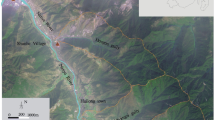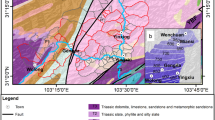Abstract
Debris flow activity increased after the Wenchuan earthquake, and many debris flows continue to occur. Recently, a catastrophic debris flow event was triggered by strong rainfall on 20 August 2019 in Wenchuan County, China. The main purposes of this article are to analyse the activity characteristics of this disaster and further to analyse the long-term activity of debris flow in Wenchuan County based on the analysis results of this disaster. According to a field survey and remote sensing image interpretation, this strong rainfall triggered 15 debris flows that occurred simultaneously in the large watershed in northern Wenchuan County, and they were characterised by strong channel erosion and a disaster chain effect. The activity and sediment supply capacity of landslides have decreased significantly, and the landslides that provided materials for this debris flow event are mainly distributed on both banks of tributaries. The amounts of triggering rainfall and antecedent accumulated rainfall for this debris flow event were 13.7 mm and 47.1 mm, respectively. In addition, the channel runoff formed by strong short-duration rainfall eroded the channel deposits, and temporary check dams failed due to slope failures; these are the main causes for debris flows in the next period. Analyses of the debris flow volume versus watershed area and the maximum erosion modulus prove that the debris flow activity in Wenchuan County is decreasing with time, but more than 5~10 years will be required to recover to the pre-earthquake level.













Similar content being viewed by others
References
Chang M, Tang C, Ni HY, Qu YP (2015) Evolution process of sediment supply for debris flow occurrence in the Longchi area of Dujiangyan city after the Wenchuan earthquake. Landslides 12:611–623
Chen NS, Yang CL, Zhou W, Hu GS, Li H, Hand D (2009) The critical rainfall characteristics for torrents and debris flows in the Wenchuan earthquake stricken area. J Mt Sci 6(4):362–372
Chen NS, Zhou W, Yang CL et al (2010) The processes and mechanism of failure and debris flow initiation for gravel soil with different clay content. Geomorphology 121(3–4):222–230
Dai FC, Xu C, Yao X, Xu L, Tu XB, Gong QM (2011) Spatial distribution of landslides triggered by the 2008 Ms 8.0 Wenchuan earthquake, China. J Asian Earth Sci 40(4):883–895. https://doi.org/10.1016/j.jseaes.2010.04.010
Fan XM, Juang CH, Wasowski J, Huang RQ, Xu Q, Scaringi G, Westen C, Havenith H (2018a) What we have learned from the 2008 wenchuan earthquake and its aftermath: a decade of research and challenges. Eng Geol 241:25–32. https://doi.org/10.1016/j.enggeo.2018.05.004
Fan RL, Zhang LM, Wang HJ, Fan XM (2018b) Evolution of debris flow activities in Gaojiagou Ravine during 2008–2016 after the Wenchuan earthquake. Eng Geol 235:1–10. https://doi.org/10.1016/j.enggeo.2018.01.017
Fan XM, Scaringi G, Korup O et al (2019a) Earthquake-induced chains of geologic hazards: patterns, mechanisms, and impacts. Rev Geophys. https://doi.org/10.1029/2018RG000626
Fan XM, Scaringi G , Guillem D et al (2019b) Two multi-temporal datasets that track the enhanced landsliding after the 2008 Wenchuan earthquake. Earth System Science Data 11(1):35-55
Ge YG, Cui P, Zhang JQ, Zeng C, Su FH (2015) Catastrophic debris flows on July 10th 2013 along the Min River in areas seriously-hit by the Wenchuan earthquake. J Mt Sci 12:186–206
Guo XJ, Cui P, Li Y, Ma L, Ge YG, William BM (2016) Intensity–duration threshold of rainfall-triggered debris flows in the Wenchuan earthquake affected area, China. Geomorphology 253:208–216
Han, W (2016) Hazard mechanism research of wide-gentle and narrow-steep charnels debris flow in Wenchuan earthquake region. Dissertation, Southwest Jiaotong University. (In Chinese)
Huang RQ, Li WL (2009) Fault effect analysis of geo-hazard triggered by Wenchuan earthquake. J Eng Geol 17:19–28 (In Chinese)
Huang RQ, Li WL (2014) Post-earthquake landsliding and long-term impacts in the Wenchuan earthquake area, China. Eng Geol 182:111–120
Koi T, Hotta N, Ishigaki I, Matuzaki N, Uchiyama Y, Suzuki M (2008) Prolonged impact of earthquake-induced landslides on sediment yield in a mountain watershed: the Tanzawa region, Japan. Geomorphology 101:0–702
Li CR, Wang M, Liu K (2018) A decadal evolution of landslides and debris flows after the Wenchuan earthquake. Geomorphology 323:1–12
Li N, Tang C, Bu XH et al (2020) Analysis of the characteristics and evolution of debris flow in Wenchuan county after the 5.12 earthquake. J Eng Geol. https://doi.org/10.13544/j.cnki.jeg.2019-310 (In Chinese)
Liu XL, Wang QC, Kong JM, He SM, Su PC (2004) Hazard assessment of debris flows and their developing trend along Dujiangyan-Wenchuan highway. J Disas Prev Mitig Eng 01:41–46 (In Chinese)
Liu YJ, Wang TW, Cai CF et al (2014) Effects of vegetation on runoff generation, sediment yield and soil shear strength on road-side slopes under a simulation rainfall test in the Three Gorges Reservoir Area, China. Sci Total Environ 485-486(3):93–102
Ma C, Hu K, Tian M (2013) Comparison of debris-flow volume and activity under different formation conditions. Nat Hazards 67:261–273
Qi S, Xu Q, Lan H, Zhang B, Liu J (2010) Spatial distribution analysis of landslides triggered by 2008.5.12 Wenchuan earthquake, China. Eng Geol 116(1):95–108
Shen P, Zhang LM, Chen HX, Gao L (2016) Role of vegetation restoration in mitigating hillslope erosion and debris flows. Eng Geol. https://doi.org/10.1016/j.enggeo.2016.11.019
Shen P, Zhang LM, Fan RL et al (2019) Declining geohazard activity with vegetation recovery during first ten years after the 2008 Wenchuan earthquake. Geomorphology 352:106989
Sidle RC, Bogaard TA (2016) Dynamic earth system and ecological controls of rainfall-initiated landslides. Earth Sci Rev 159:275–291
Tan WP, Wang CH, Yao LK (1994) The regional forecast and prediction in landslide and debris flow. Pp.114-115
Tang C (2010) Activity tendency prediction of rainfall induced landslides and debris flows in the wenchuan earthquake areas. J Mt Sci 28:341–349 (In Chinese)
Tang LQ (2012) The risk assessment of debris flow after the Wenchuan earthquake along Yingxiu-Wolong highway of S303 line. Dissertation, Chengdu University of Technology. (In Chinese)
Tang C, van Westen CJ (2018) Atlas of Wenchuan-earthquake geohazards: analysis of co-seismic and post-seismic geohazards in the area affected by the 2008 Wenchuan earthquake. Science Press, Beijing
Tang C, Zhu J, Li WL, Liang JT (2009) Rainfall-triggered debris flows following the Wenchuan earthquake. Bull Eng Geol Environ 68:187–194
Tang C, Zhu J, Ding J, Cui XF, Chen L, Zhang JS (2011a) Catastrophic debris flows triggered by a 14 August 2010 rainfall at the epicenter of the Wenchuan earthquake. Landslides 8:485–497
Tang C, Zhu J, Qi X, Ding J (2011b) Landslides induced by the Wenchuan earthquake and the subsequent strong rainfall event: a case study in the Beichuan area of China. Eng Geol 122(01):22–33
Tang C, Asch TWJV, Chang M, Chen GQ, Zhao XH, Huang XC (2012) Catastrophic debris flows on 13 August 2010 in the Qingping area, southwestern China: the combined effects of a strong earthquake and subsequent rainstorms. Geomorphology 139-140:559–576
Tang C, Jiang ZL, Li WL (2015) Seismic landslide evolution and debris flow development: a case study in the Hongchun catchment, Wenchuan area of China. In: Lollino G et al (eds) Engineering geology for society and territory - Volume 2. Springer, Cham. https://doi.org/10.1007/978-3-319-09057-3_72
Tang C, Westen CJV, Tanyas H, Jetten VG (2016) Analysing post-earthquake landslide activity using multi-temporal landslide inventories near the epicentral area of the 2008 Wenchuan earthquake. Nat Hazards Earth Syst Sci 16(12):1–26
Wu SR, Shi JS, Wang HB (2011) Analysis of activity intensity for landslides triggered by the Wenchuan earthquake, Sichuan Province, China. Environ Earth Sci 65(04):1021–1028
Xu ZX (1985) The prevention and control of debris flow of Qipan gully in Wenchuan county, Sichuan province. Mt Res 03:166–172 +193-194. (In Chinese)
Xu C, Dai FC, Yao X (2009) Incidence number and affected area of Wenchuan earthquake induced landslides. Sci Technol Rev 27(11):79–81 (In Chinese)
Xu C, Xu XW, Yao X et al (2014) Three (nearly) complete inventories of landslides triggered by the May 12, 2008 Wenchuan Mw 7.9 earthquake of China and their spatial distribution statistical analysis. Landslides 11:441–461
Yang ZQ, Hou KP, Guo TT, Niu XD, Lu YF (2015) Activity evaluation of debris flow disasters in NiuMiangou Valley, the epicentre of Wenchuan earthquake. Electron J Geotech Eng 20(21):89–97
Yu B, Wu Y, Chu S (2014) Preliminary study of the effect of earthquakes on the rainfall threshold of debris flows. Eng Geol 182:130–135
Zhang S, Zhang LM (2017) Impact of the 2008 Wenchuan earthquake in China on subsequent long-term debris flow activities in the epicenter area. Geomorphology 276:86–103
Zhang JS, Shen XJ, Xie H (2005) The characteristics and control of the low frequency debris flow—taking the Chayuan gully debris flow Wenchuan County, Sichuan Province as a example. Chin J Geol Hazard Control 03:37–41 (In Chinese)
Zhang LL, Liu X, Li Y, Liu Y, Liu Z, Lin J, Shen J, Tang X, Zhang Y, Liang W (2012) Emergency medical rescue efforts after a major earthquake: lessons from the 2008 Wenchuan earthquake. Lancet 379(9818):853–861
Zhang Y, Cheng Y, Yin Y et al (2014) High-position debris flow: a long-term active geohazard after the Wenchuan earthquake. Eng Geol 180:45–54
Zhang S, Zhang LM, Lacasse S, Nadim F (2016) Evolution of mass movements near epicentre of Wenchuan earthquake. the First Eight Years, Scientific Reports, 6,36154
Zhou W, Tang C (2014) Rainfall thresholds for debris flow initiation in the Wenchuan earthquake-stricken area, southwestern China. Landslides 11(05):877–887
Zhu H, Zhang LM (2019) Root-soil-water hydrological interaction and its impact on slope stability. Georisk 13(4):349–359
Zhu J, Ding J, Liang JT (2011) Influences of the Wenchuan earthquake on sediment supply of debris flows. J Mt Sci 8:270–277
Funding
This research was financially supported by the National key research and development programme of China (Grant No. 2017YFC1501004) and the National Natural Science Foundation of China (Grant No. 41672299).
Author information
Authors and Affiliations
Corresponding author
Rights and permissions
About this article
Cite this article
Xiong, J., Tang, C., Chen, M. et al. Activity characteristics and enlightenment of the debris flow triggered by the rainstorm on 20 August 2019 in Wenchuan County, China. Bull Eng Geol Environ 80, 873–888 (2021). https://doi.org/10.1007/s10064-020-01981-x
Received:
Accepted:
Published:
Issue Date:
DOI: https://doi.org/10.1007/s10064-020-01981-x




